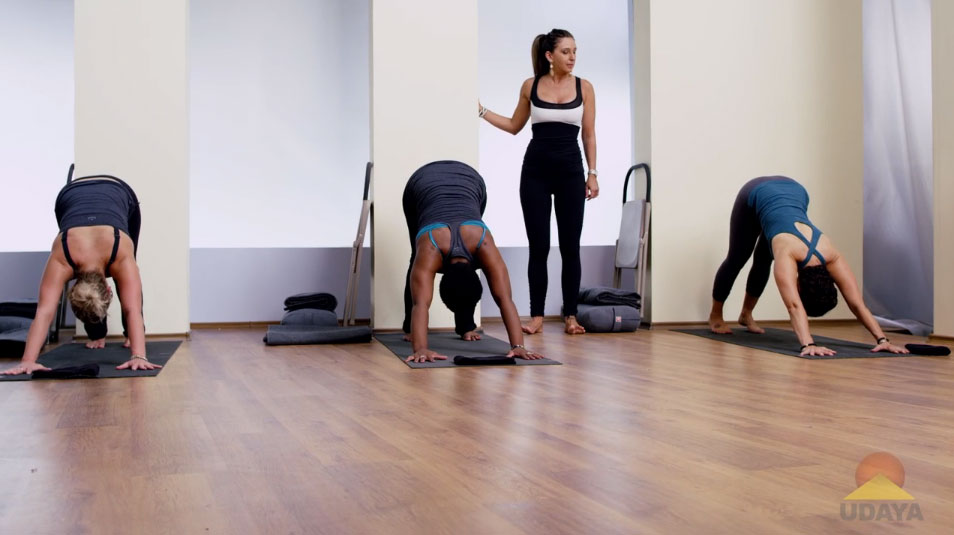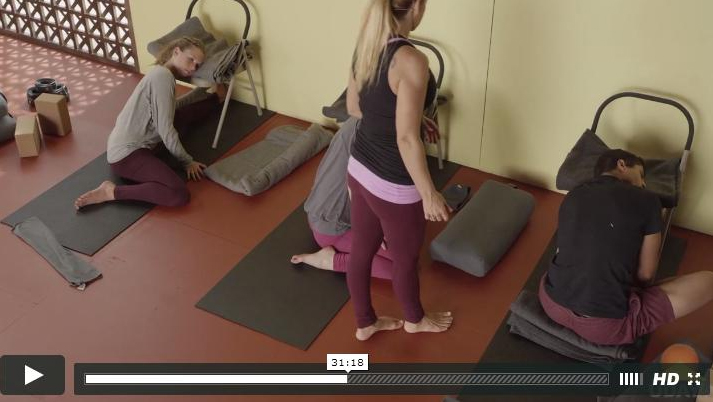
I come from science. Yeah. That’s pretty much it.
To spare you the years and years of scientific data I’ve researched, I make it easy in a yoga class. I give you a prop. Despite what people may think, I don’t give you a prop because you can’t do it or you’re not good enough. I actually give you a prop to direct the load (i.e. force of gravity or muscle force) so that you get the stretch where you actually need it, not where you habitually get it.
Believe it or not, for about the last century, scientists have been researching what happens to our bilogical tissues under compressive and tensile loads. It’s not a secret. There are journals dedicated to publishing the ongoing research on this topic. These biomechanical scientists would make great yoga teachers . Really. Okay, maybe their labratory demeanor won’t pass the Udaya standards committee evaluation. But you get the idea.
While I could write a book – wait a minute, I am writing a book – on the subject of tissue mechanics, I will introduce you here to connective tissue. Connective tissue is all over the body and does a lot more than it’s name reveals (connect things). Connective tissue shows up in the musculoskeletal system as fascia, ligaments, and tendons. It’s made of fibrous materials like collagen and elastin, plus some cells, some ground substances and proteins, lots and lots of water, and a bunch of other stuff that doesn’t apply to this blog. It’s the collagen that we are going to talk about.
Collagen is material that can be stretched. Like a really, really, really stiff rubber band. But like anything that can be stretched, it has a mechanical limit. If you stretch it within that limit, it behaves elastically – meaning it can return to it’s original shape. If you stretch it beyond that mechanical limit, it behaves plastically, meaning it will be permanently deformed. Permanently deformed equals damaged tissue. We don’t really want that do we? Stretch it even more and eventually, you will get total failure. Your rubber band will snap apart. We really don’t want that.
Here’s a handy diagram I made for you to help you visualize what I just wrote:
The vertical axis (y-axis for those of you who remember high school algebra) is the stress applied. That’s the nerdy way of say applied load or force. When you’re stretching, the applied stress is how much force is pulling on the tissue.
The horizontal axis is the strain – nerd speak for deformation.
Collagen fibers have a little crimp to them. Like when we crimped our hair in the 80’s. When you stretch the collagen, at first, the crimp straightens. That’s call the toe region. The collagen deforms a bit by getting longer and then the crimp returns when the load is removed.
Keep stretching (applying the load) and the tissue deforms a bit more. You’re still in the elastic region, the safe region. How much the collagen can deform is called yield. As long as you stretch below the yield point, you have not done tissue damage.
But stretch beyond the yield point and you have entered the plastic region. This when fibers begin to tear. Repairing these fibers is a slow process that can take up to 2-3 years. Tearing these fibers weakens the structural integrity of the tissues. That means it won’t do the best job holding you together that it can. If you keep applying that tensile load, the ultimate fail point is the end of the game.
Now this collagen is extremely strong and resilient material. It takes a lot of force to distend the tissue. So tearing your own connective tissue apart during a yoga pose, barring unforeseen accidents, isn’t too likely. However, entering the plastic region is not only possible, but depending on your genetics, also likely in certain yoga poses. Distend the tissue between 4% – 8% and you’re in the plastic region. That is not a typo. Four percent, 4%, is not a lot!!!!
Here’s the good news. Finally.
What most people don’t know is that these collagen fibers are constantly remodeling and turning over. The cool thing is that the cells are signaled to remodel the collagen based on the stretch they sense. Even the cells are little mechanical entities. Am I the only one who thinks that’s cool?
Essentially, the properties of these connective tissues adapt to stretching loads. They will adjust their strength, stiffness (stiff is good in a biomechanical context), length, and yield points based on the stretching loads. As long as you don’t damage the collagen. Repairing tissue damage is not the same as turnover and remodeling. Stretch frequently without overloading and you will get results with less likelihood of tissue damage.
In summary, if I’m giving you a prop suggestion it’s because I have a mechanical reason for directing the load. If I told you all of this every time I handed you block or rolled up blanket to put under you, we’d never get through class. Instead, I blunder my way through instructions and hope you trust me.
See you on the mat!
Jules
PS. I LOVE questions and I give answers. Find me in the Udaya facebook group on contact me through my website: www.JulesMitchell.com



Write Your Comment
Leave a comment